Proper site selection, soil preparation, planting method, irrigation system, and training are essential for developing a productive Kiwi fruit. Kiwi fruit can be grown in hot and humid environments. A deep yellow-brown loamy soil with well-drained and fertile soil is ideal for Kiwi cultivation. Kiwi fruit is also called Chinese gooseberry. This little sweet and tangy fruit contains many nutrients and health benefits.
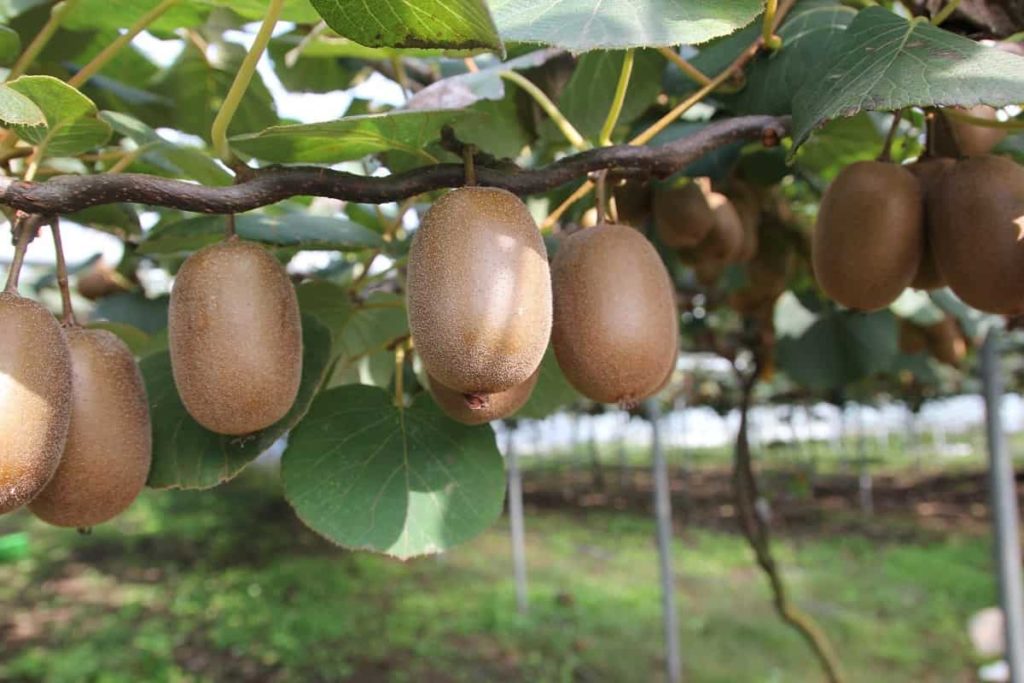
Kiwi fruit, also called “Kiwi,” is a popular type of edible berry that grows on oxen in temperate regions. Although each vine can produce hundreds of pounds of fruit, it usually takes three to seven years for these plants to reach maturity. So let’s check out the top 15 steps to boost Kiwi yield.
Top 15 steps to boost Kiwi yield
Step 1: Soil preparation for good plant growth
It prefers loamy and sandy soils rich in organic matter and deep yellow and brown; it should also have a drainage system. For good yield, you need a soil pH of 6.3 to 7.3. In addition, the soil has a good amount of nitrogen, potassium, and phosphorus during its vegetation stage.
Step 2: Space for improving fruit production
Kiwi fruit is robust vines that need more space to grow. Each vine will need about 5-meter space on a solid support such as a fence or pergola. In addition, regular harvesting will be required to control oxen and improve fruit production.
Step 3: Land preparation for Kiwi fruit cultivation
The soil should be kept at a level so use a plow so that the soil can be brought into good cultivation. Don’t forget to remove the weeds.
Step 4: Planting season to encourage vigorous growth
Planting is usually done in January. Kiwi planting should be done at the same depth as the plants were growing in the nursery. The soil should be firmly planted around the roots. Plants are strictly cut to about 30 cm.
Step 5: Tips for growing healthy Kiwi vines
Look for a fully sunny spot. Next, look for a bright spot to find where best to plant Kiwi vines on your property. Next, place each vine ten to twelve feet apart to allow them enough space to grow and spread. Finally, make sure you also have easy access to water. Kiwi fruits need plenty of water to keep them healthy unless they are well established and grow nutritious fruits and roots.
In case you missed it: Kiwifruit Gardening For Beginners – How to Start
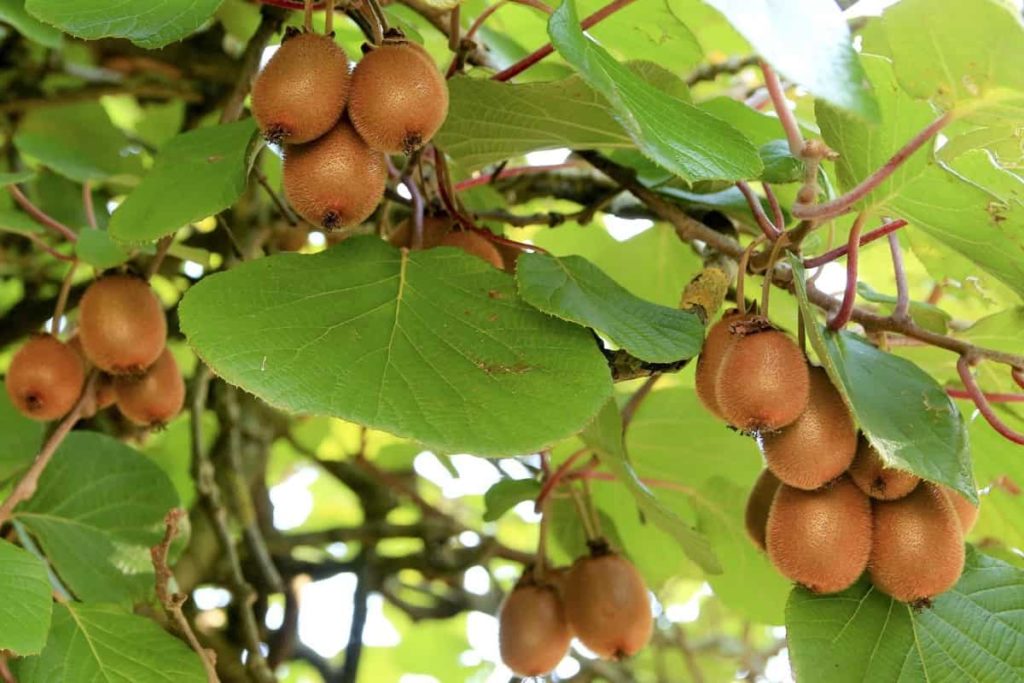
Step 6: Trellis for growing Kiwi vines fast
Kiwi vines grow fast and will need the help of a solid trellis to catch them. Some species are famous for growing up to 40 feet tall. As young plants grow, you will need to train them to grow trellis. It is easy as using the wire to tie the oxen with the support system of your choice and cutting the oxen that do not obey them or become too wild to bring them back.
Step 7: Nutrients for better yield and bigger fruit
Nutrition use affects yield, fruit quality, fruit maturity, and plant vigor. Nitrogen is an essential element for better and larger Kiwi fruit production. In the first half of plant growth, nitrogen feeders require many applications. The use of nitrogen will improve the dimensions of the fruit, but caution is still given as the fruit can be stored poorly later.
For the excellent growth of Kiwi, 20 kg of farmyard manure and 0.5 kg of NPK mixture containing 15% nitrogen are required every year. After five years, apply the same amount of FYM and NPK as described, use 850-900 grams of nitrogen, 500-600 grams of phosphorus, and 800-900 grams of potassium each year.
Kiwi fruit grows on fast-growing vines. Hardy Kiwis typically tolerate the pH of almost any soil and any well-drained soil but benefit from the addition of large amounts of organic matter. Training, harvesting, mulching, and watering are essential components of vine care, but feeding Kiwi fruit vines will encourage better yields and more significant frIn addition, knowing wing when to fertilize Kiwis will ensure large healthy plants with large flowers.
Young plants are sensitive to fertilizer, but once they have taken off after the first year, do not forget this critical step. Soil characteristics such as low pH and poor drainage can be vital limiting factors in achieving high yields. Increasing fertilizer prices or adding nutrients to an adequate supply will not correct these limiting factors. Therefore, fertilizer use should be part of the complete management package.
In case you missed it: Kiwi Farming, Kiwi Planting, Kiwi Fruit Cultivation Practices
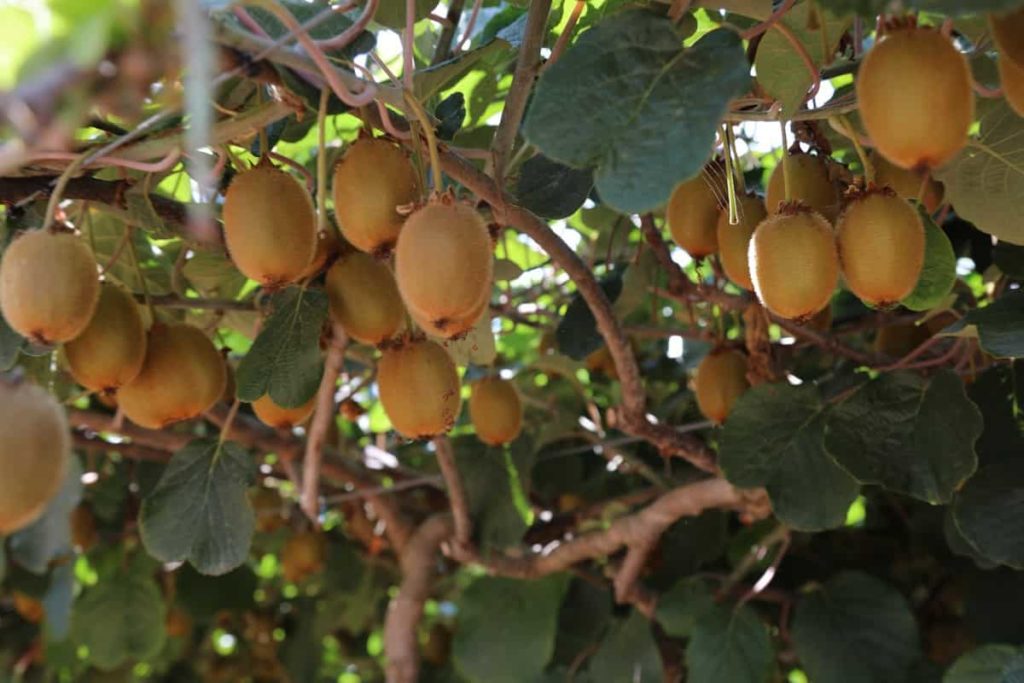
Step 8: Reasons for Kiwi leaves turning brown
When you see the edges of Kiwi leaves turning brown, check the planting area. Kiwis need the sun to thrive and produce fruit, but if the sun stays hot for too long, it can burn the edges of the leaves. This condition is called leaf scorching, and it can be caused by too little irrigation during a drought. Too little water can cause the plant leaves to fall off the vines. Kiwi plants need regular watering in summer. When you see your Kiwi leaves turn yellow, it may be a lack of nitrogen.
Kiwis are heavy nitrogen feeders, and if the plant is not getting enough nitrogen, then the yellowing is a sign. You will need to apply a lot of nitrogen fertilizer during the first half of the growing season. You can spread grapefruit and avocado tree manure on the soil around the vine in early spring, but you will need to add more in early summer. Mulching with organic matter can also help yellow Kiwi plants to turn yellow. Well-decomposed manure or fertilizer on the soil will provide a constant nitrogen supply. Prevent mulch from touching stems or foliage.
Step 9: How to prevent fruit drop on Kiwi plants
Like all fruits, Kiwi vines can experience immature fruit drops. The two main reasons for fruit peeling in Kiwis are water pressure and poor or lack of pollination. You should reap a total harvest of fully ripe fruit if you pay close attention to these two things when growing and caring for your Kiwi plants. The Kiwi fruit drop is the advice of many Kiwi growers. Kiwi fruit drop occurs mainly with the external environment, nutrition accumulation and distribution, and pollination.
Step 10: Irrigation for healthy plant growth
Irrigation is essential to keep the vines growing and productive and maximize fruit size. Water taken by the Kiwi fruit vine is lost through transpiration, a process by which the water vapor in the plants is transferred to the air. The plant uses only a small part. Water and some nutrients are absorbed from the roots and transmitted through the plant. Water evaporates inside the leaves and is transferred through the stomata or pores in the leaves.
The surface area of a mature vine canopy is approximately 75 to 125 square feet, so too much water can be lost through crop transport. The water requirement will also depend on several factors, including the weather, the age of the plants, the type of Kiwi fruit, cultivation, soil conditions, and cultural practices. Irrigation should be provided in September-October when the fruits are in the early growth stage.
In case you missed it: Grapefruit Gardening, How To Start, Tips, and Ideas
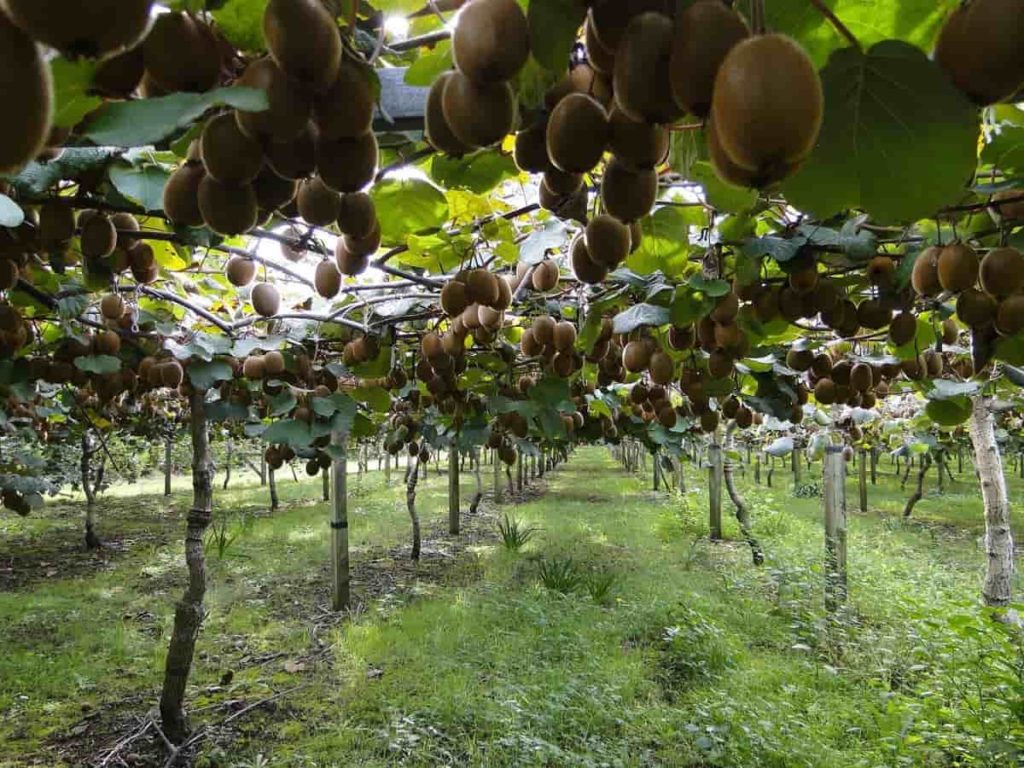
Irrigation at intervals of 10-15 days is beneficial for the healthy development of plants and fruits. Kiwi fruit production requires a good supply of good quality water. Water should be available during the growing season, either by rain or irrigation. The need for water depends on the climate, the age of the plants, and the irrigation method. Plants need water in dry weather. But too much water is bad for the Kiwi plant. It will ensure the healthy growth of the Kiwi fruit plant.
Step 11: Reasons for Kiwi plan not blooming
Age
If your Kiwi is not blooming, it could be for several reasons. First, Kiwi plants reach a certain maturity before flowering. Typically, this takes up to three years. Sometimes it takes longer.
Temperature
Like many other fruit plants, Kiwis require cold winter hours (0 and 7C) to plant flowers and fruits. The number of hours depends on the crop. Make sure you buy Kiwi vines that suit your climate. Check with your local nursery before buying. Note that temperatures above 15 C reduce the total cold times. Winter heatwaves can reduce the total number of winter hours below the threshold required for Kiwis to flower.
Poor location
If your Kiwi vines are mature and get quite cool hours, you may still wonder how to feed the Kiwi plants. First, make sure you’ve installed them in the right place. Kiwi plants need full sunshine and appreciate some afternoon shade in warmer climates. They also need well-drained soil, regular watering, and good drainage.
In case you missed it: Persimmon Gardening, How To Start, Tips, and Ideas
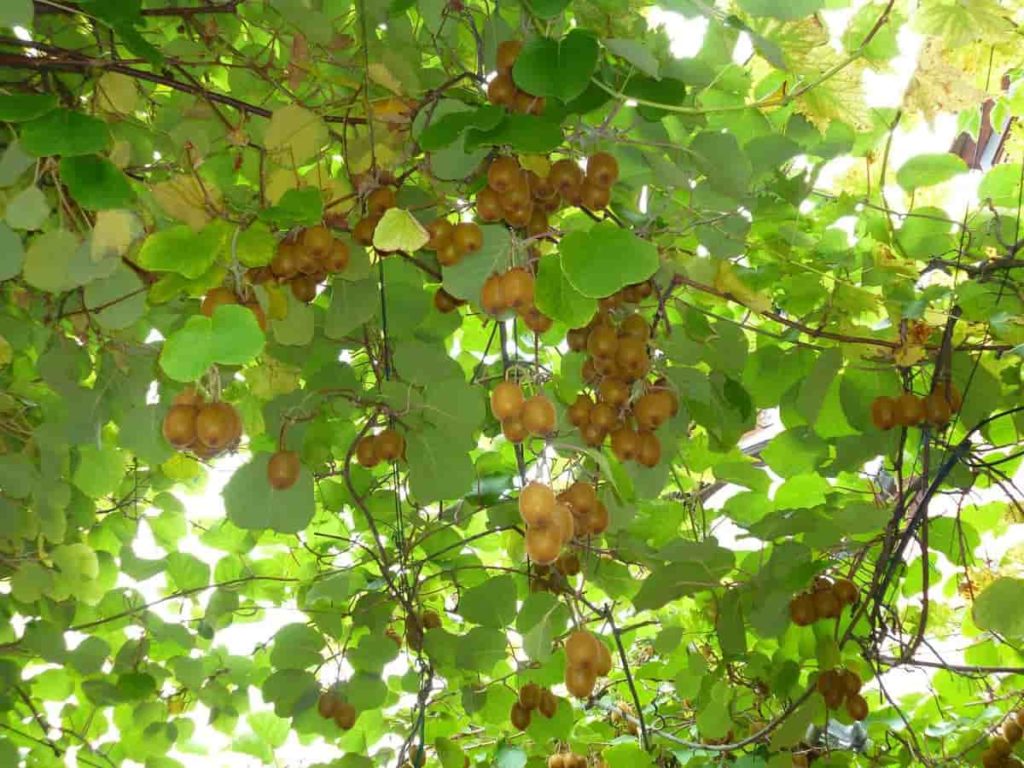
If your Kiwi is not blooming, it may be due to insufficient sunlight, excessively dry soil, waterlogged soil, or adequate nutrients in the ground. Adjust these conditions if your Kiwi does not flower by adding annual fertilizer, adjusting your irrigation, or if you have to transplant your vine to a sunny place.
Step 12: Tips for better Kiwi production
- Plant verity selection is essential, and you already know it depends on the season or time of planting and harvesting.
- Kiwi veins will be fruitful for 35 to 40 years. But in the first few years, the fruit is usually smaller than the normal fruit we see in stores.
- It has a long lifespan, so care and maintenance should be the same for longevity.
- A common feature of different veins is that they are very nitrogen hungry. We have observed that nitrogen can increase fruit size. Mulching with manure or straw is beneficial.
Step 13: Pruning and training for maintaining plant growth
Knowing when to prune Kiwi vines throughout the year will keep them healthy and limit their size. Proper pruning and training for Kiwi trees are necessary for several reasons;
- It is essential for maintaining a well-formed permanent framework for the vine during the years of establishment.
- When the Kiwi fruit vines mature, strike a balance between plant growth and fruit production.
- To maintain continuous production and fruit size year after year.
- To make a canopy that uses the available light efficiently (for photosynthesis) yet is open enough to produce maximum fruit quality and flower buds for next year’s crop.
Kiwi plant training requires training to establish and maintain a well-formed main branch and fruiting arm framework. Supporting branches are erected as soon as possible, even before or after planting the oxen. It forms three types of supporting structures (fences). Sometimes a wire fence is applied through another wire, and then the system takes the form of a Kniffin device. Above the pillars, 1.8-2.0 meters, is a 2.5 mm thick tensile wire.
In case you missed it: Agriculture In South Korea, How To Start
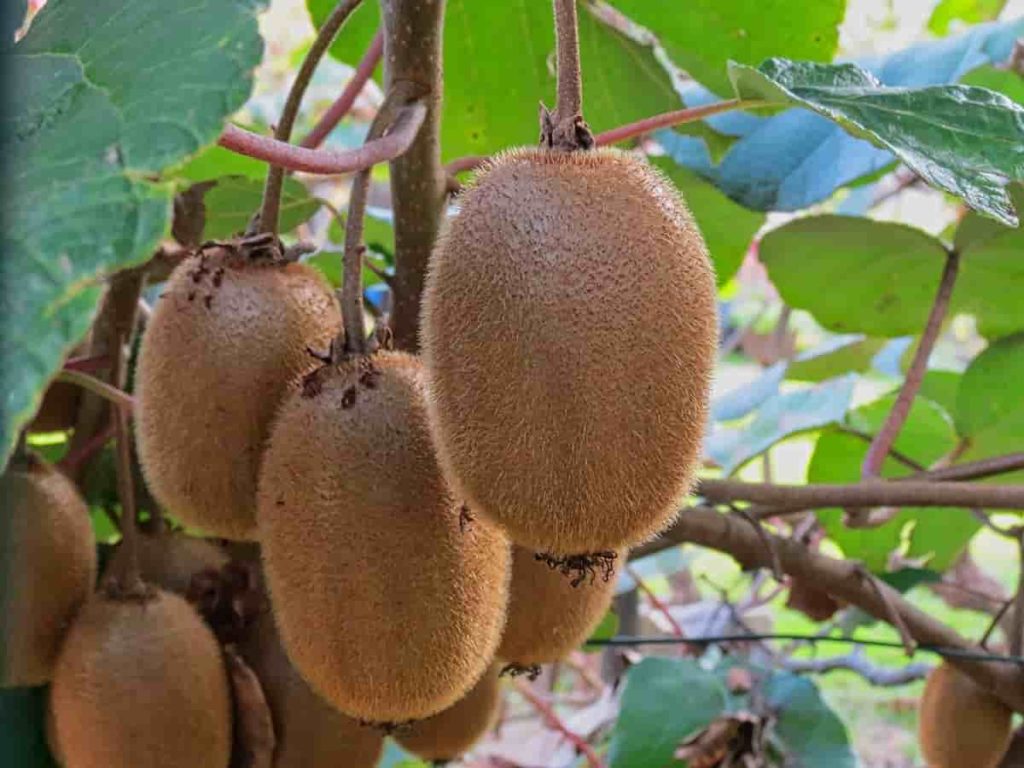
The tension of the wire should not be too high at the time of installation; otherwise, the wire will break from the knot due to crop load. A cross arm (1.5 m) also has two out trigger wires at the ends. This instruction is called a tee bar or overhead trellis device. The lateral three wiring from the main branch is placed on the canopy. A flat-top network or criss-cross wire is developed during the pergola or bower scheme to train the vines. This method is expensive and difficult to maintain but provides high productivity.
Sep 14: Plant care tips for getting more yield
Phytophthora crown and root rot – Soggy drained soil and high humidity are responsible for Phytophthora crown, a disease that is easily seen in reddish-brown roots and crowns. Proper moisture management can prevent disease. Fungicides are sometimes effective.
Armillaria root rot
Kiwi plants affected by Armillaria root rot usually have stunted growth under the bark and appear brown or white, shoestring-like mass. This soil-borne fungal disease is more common when the soil is over-watered or has poor drainage.
Bacterial blight
Yellow spots and brown spots on petals and buds are signs of bacterial blight, a disease that enters plants from injured areas. In Kiwi farming, root rot, especially in areas with poor drainage, can be exacerbated by phytophthora soil fungus infection. In addition, gray mold botrytis root affects flowers and young fruits in humid climates.
Botrytis fruit rot
It is also known as gray mold, the botrytis fruit rot causes the ripe Kiwi fruit to soften and turn red with a gray growth that appears mainly on the tip of the stem. It is more common in the rainy season or during high humidity periods. Fungicides can be effective if used during the pre-harvest period.
Crown gall
This bacterial disease enters plants from injured areas, resulting in weak plants, small leaves, and reduced yields.
Bleeding canker
As the name implies, bleeding canker is evidenced by rusty cankers on the branches, which produce an ugly reddish substance. Bleeding canker is a bacterial disease that primarily controls an infected growth about 12 inches (30 cm) below the canker.
Step 15: Harvesting tips to maximize fruit production
Kiwi vines grow at 4-5 years while commercial production starts at 7-8 years. At lower altitudes, fruits ripen earlier and later due to temperature changes. Larger berries are picked first, while smaller ones are allowed to grow in size. Healthy fruits were brought to the market. After that, they lose their strength in two weeks and become edible.
- Types of Pesticides Used in Agriculture: A Beginner’s Guide
- Economical Aquaculture: A Guide to Low-Budget Fish Farming
- 15 Common Planting Errors That Can Doom Your Fruit Trees
- How to Make Houseplants Bushy: Effective Tips and Ideas
- Innovative Strategies for Boosting Coconut Pollination and Yield
- Pollination Strategies for Maximum Pumpkin Yield
- The Complete Guide to Chicken Fattening: Strategies for Maximum Growth
- Natural Solutions for Tulip Problems: 100% Effective Remedies for Leaf and Bulb-Related Issues
- Revolutionizing Citrus Preservation: Towards a Healthier, Greener Future
- Natural Solutions for Peony Leaf and Flower Problems: 100% Effective Remedies
- Maximizing Profits with Avocado Contract Farming in India: A Comprehensive Guide
- Natural Solutions for Hydrangea Problems: 100% Effective Remedies for Leaf and Flowers
- The Ultimate Guide to Choosing the Perfect Foliage Friend: Bringing Life Indoors
- From Sunlight to Sustainability: 15 Ways to Use Solar Technology in Agriculture
- The Ultimate Guide to Dong Tao Chicken: Exploring from History to Raising
- The Eco-Friendly Makeover: How to Convert Your Unused Swimming Pool into a Fish Pond
- Mastering the Art of Delaware Chicken Farming: Essentials for Healthy Backyard Flocks
- 20 Best Homemade Fertilizers for Money Plant: DIY Recipes and Application Methods
- How to Craft a Comprehensive Free-Range Chicken Farming Business Plan
- Brighten Your Flock: Raising Easter Egger Chickens for Beauty and Bounty
- How to Optimize Your Poultry Egg Farm Business Plan with These Strategies
- Subsidy for Spirulina Cultivation: How Indian Government Schemes Encouraging Spirulina Farmers
- Ultimate Guide to Raising Dominique Chickens: Breeding, Feeding, Egg-Production, and Care
- Mastering the Art of Raising Jersey Giant Chickens: Care, Feeding, and More
- Ultimate Guide to Raising Legbar Chickens: Breeding, Farming Practices, Diet, Egg-Production
- How to Raise Welsummer Chickens: A Comprehensive Guide for Beginners
- How to Protect Indoor Plants in Winter: A Comprehensive Guide
- Ultimate Guide to Grow Bag Gardening: Tips, Tricks, and Planting Ideas for Urban Gardeners
- Guide to Lotus Cultivation: How to Propagate, Plant, Grow, Care, Cost, and Profit
- Agriculture Drone Subsidy Scheme: Government Kisan Subsidy, License, and How to Apply Online
- Ultimate Guide to Raising Araucana Chickens: Breed Profile, Farming Economics, Diet, and Care
- Bringing Hydroponics to Classroom: Importance, Benefits of Learning for School Students
- Ultimate Guide to Raising Polish Chickens: Breed Profile, Farming Economics, Diet, and Care
- Ultimate Guide to Raising Australorp Chickens: Profile, Farming Economics, Egg Production, Diet, and Care
- Silkie Chicken Farming: Raising Practices, Varieties, Egg Production, Diet, and Care
- Sussex Chicken Farming: Raising Practices, Varieties, Egg Production, Diet and Care